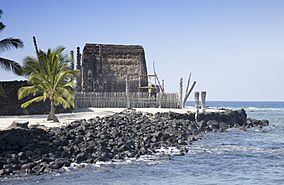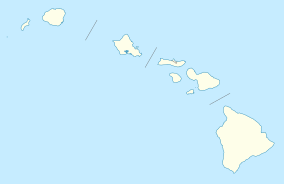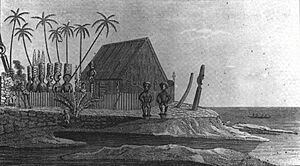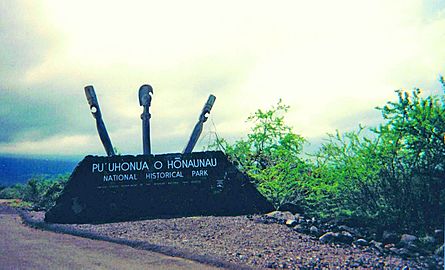Puʻuhonua o Hōnaunau National Historical Park facts for kids
Quick facts for kids Puʻuhonua o Hōnaunau National Historical Park |
|
|---|---|

Reconstructed Hale o Keawe
|
|
| Location | Hawaii County, Hawaii, United States |
| Nearest city | Holualoa, Hawaiʻi |
| Area | 420 acres (170 ha) |
| Established | July 26, 1955 |
| Visitors | 421,027 (in 2016) |
| Governing body | National Park Service |
| Website | Puʻuhonua o Hōnaunau National Historical Park |
Puʻuhonua o Hōnaunau National Historical Park is a special place on the west coast of the Big Island of Hawaiʻi. It's a National Historical Park in the U.S. state of Hawaii. For hundreds of years, this park was a "place of refuge" or puʻuhonua for ancient Hawaiians.
Imagine if you accidentally broke an important rule, called a kapu. In old Hawaii, breaking a kapu could mean death! But if you could reach a puʻuhonua, you would be safe. A priest would forgive you, and you could leave freely. Even warriors who lost a battle or people not fighting could find safety here during wars. The land just outside the big wall of the puʻuhonua was home to powerful chiefs for many years.
Puʻuhonua o Hōnaunau is one of only four places in Hawaii where the flag of Hawaii can fly by itself, without the American flag. The other places are ʻIolani Palace, the Mauna ʻAla, and Thomas Square.
Contents
Welcome to Puʻuhonua o Hōnaunau!
This amazing park covers 420 acres (about 1.7 square kilometers). It was first created in 1955 and called "City of Refuge National Historical Park." Later, in 1978, its name was changed. In 2000, the name was updated again to use the correct Hawaiian spelling, becoming Puʻuhonua o Hōnaunau.
The park protects many ancient sites. These include old temple platforms, royal fishponds, and even tracks used for sledding! You can also see parts of old coastal villages. Some buildings, like the Hale o Keawe temple and several traditional thatched houses, have been rebuilt so visitors can see what they looked like long ago.
The Ancient Hale o Keawe Temple
The Hale o Keawe was an important ancient Hawaiian heiau, which is a type of temple. It was built around 1650 AD. This temple was a special burial place for the ruling chiefs, known as aliʻi nui, of the Island of Hawaii.
Who Was Buried Here?
The temple was built by a chief named Kanuha for his father, Keaweʻīkekahialiʻiokamoku. Many other important chiefs from the Kona area were buried here too. The last person buried in the Hale o Keawe was a son of Kamehameha I in 1818. People believed that the bones of these chiefs held special power, called mana, which helped protect the place of refuge.
The Temple's History
The Hale o Keawe temple was located near a large ancient wall, close to where the royal family lived. Other chiefs' homes were built further south. Digs in the area show that many craftspeople lived nearby, supporting the royal family.
After the old Hawaiian religion was no longer practiced, most temples were destroyed. However, the Hale o Keawe survived for several years. In 1825, a man named Lord George Byron took some items from the temple. Later, in 1829, a powerful leader named High Chiefess Kapiʻolani ordered the remaining bones of the chiefs to be moved. She hid them in the cliffs above Kealakekua Bay. She then ordered this last temple to be taken apart. The bones were later moved to the Royal Mausoleum of Hawaii in 1858.
The Hale o Keawe temple you see in the park today was carefully rebuilt in the 1960s.
See also
 In Spanish: Parque histórico nacional Puʻuhonua o Hōnaunau para niños
In Spanish: Parque histórico nacional Puʻuhonua o Hōnaunau para niños






